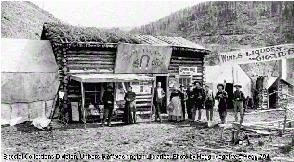- Capital
- Whitehorse
- Other major cities
- Dawson City
- Date Entered the Federation
- June 13, 1898
- Territorial Flower
- Fireweed
- Territorial Bird
- Common Raven
- Population
- 44,238 (2023)
- Area
- 482 443 sq km
- Commissioner
- The Honourable Adeline Webber
- Premier
- The Honourable Mike Pemberton (Liberal Party)
|

|
Click on the picture for free downloads
including this image. |
|
The modern history of Yukon dates from 1825, when Sir John Franklin visited the north coast. The Hudson's Bay Company established trading posts along the Yukon River in the 1840s, and discoveries of gold in creeks and rivers began to be reported in the 1860s. The region remained virtually uninhabited, however, until 1896, the year of the Klondike gold strike. Two years later, at the peak of the gold rush, the population of Dawson alone was more than 40 000. Some $100 million worth of gold was discovered in the region between 1896 and 1904.
With the subsequent exhaustion of rich placer deposits, the population began to decline; by 1921 there were only 4157 persons in the territory. The population began to rise during World War II with the construction of a section of the Alaska Highway; in 1941 it was 4914. Further increase was stimulated in the 1950s by the setting up of distant early warning (DEW) line radar stations. Since 1960, with the resurgence of mining, the population has continued to grow, more rapidly than in the nation as a whole. Between 1971 and 1991 the rate of increase was 51.1 percent, nearly double the rate for Canada as a whole.
 |
| Klondike Gold Rush |
|---|
During the 1980s, the Yukon government sought to diversify the economy, resolve Indigenous land claims, and increase territorial autonomy. Yukon experienced a severe recession in the early 1980s; by mid-decade, however, mining had revived, and tourism had become a major source of economic growth. In the late 1980s, the Council for Yukon Indians, representing Yukon Territory's 13 Indigenous tribes, reached agreement with the territorial government on a land-claims settlement under which the Indigenous peoples would receive $240 million in compensation and about 41,400 sq km of land.
|




